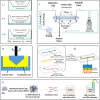In-vitro blood-brain barrier models for drug screening and permeation studies: an overview
- PMID: 31695329
- PMCID: PMC6805046
- DOI: 10.2147/DDDT.S218708
In-vitro blood-brain barrier models for drug screening and permeation studies: an overview
Abstract
The blood-brain barrier (BBB) is comprised of brain microvascular endothelial central nervous system (CNS) cells, which communicate with other CNS cells (astrocytes, pericytes) and behave according to the state of the CNS, by responding against pathological environments and modulating disease progression. The BBB plays a crucial role in maintaining homeostasis in the CNS by maintaining restricted transport of toxic or harmful molecules, transport of nutrients, and removal of metabolites from the brain. Neurological disorders, such as NeuroHIV, cerebral stroke, brain tumors, and other neurodegenerative diseases increase the permeability of the BBB. While on the other hand, semipermeable nature of BBB restricts the movement of bigger molecules i.e. drugs or proteins (>500 kDa) across it, leading to minimal bioavailability of drugs in the CNS. This poses the most significant shortcoming in the development of therapeutics for CNS neurodegenerative disorders. Although the complexity of the BBB (dynamic and adaptable barrier) affects approaches of CNS drug delivery and promotes disease progression, understanding the composition and functions of BBB provides a platform for novel innovative approaches towards drug delivery to CNS. The methodical and scientific interests in the physiology and pathology of the BBB led to the development and the advancement of numerous in vitro models of the BBB. This review discusses the fundamentals of BBB structure, permeation mechanisms, an overview of all the different in-vitro BBB models with their advantages and disadvantages, and rationale of selecting penetration prediction methods towards the critical role in the development of the CNS therapeutics.
Keywords: BBB; BMECs; CNS; TJs; blood-brain barrier; brain microvascular endothelial cells; central nervous system; iPSCs; in-silico prediction methods; induced pluripotent cells; proteins; tight junctions.
© 2019 Bagchi et al.
Conflict of interest statement
The authors report no conflicts of interest in this work.
Figures




Similar articles
-
Blood-Brain Barrier (BBB)-Crossing Strategies for Improved Treatment of CNS Disorders.Handb Exp Pharmacol. 2024;284:213-230. doi: 10.1007/164_2023_689. Handb Exp Pharmacol. 2024. PMID: 37528323
-
Revisiting the blood-brain barrier: A hard nut to crack in the transportation of drug molecules.Brain Res Bull. 2020 Jul;160:121-140. doi: 10.1016/j.brainresbull.2020.03.018. Epub 2020 Apr 18. Brain Res Bull. 2020. PMID: 32315731 Review.
-
The barrier and interface mechanisms of the brain barrier, and brain drug delivery.Brain Res Bull. 2022 Nov;190:69-83. doi: 10.1016/j.brainresbull.2022.09.017. Epub 2022 Sep 23. Brain Res Bull. 2022. PMID: 36162603 Review.
-
Blood-brain barrier structure and function and the challenges for CNS drug delivery.J Inherit Metab Dis. 2013 May;36(3):437-49. doi: 10.1007/s10545-013-9608-0. Epub 2013 Apr 23. J Inherit Metab Dis. 2013. PMID: 23609350 Review.
-
Recent progress and new challenges in modeling of human pluripotent stem cell-derived blood-brain barrier.Theranostics. 2021 Nov 2;11(20):10148-10170. doi: 10.7150/thno.63195. eCollection 2021. Theranostics. 2021. PMID: 34815809 Free PMC article. Review.
Cited by
-
Human mini-blood-brain barrier models for biomedical neuroscience research: a review.Biomater Res. 2022 Dec 16;26(1):82. doi: 10.1186/s40824-022-00332-z. Biomater Res. 2022. PMID: 36527159 Free PMC article. Review.
-
Chromatographic Data in Statistical Analysis of BBB Permeability Indices.Membranes (Basel). 2023 Jun 26;13(7):623. doi: 10.3390/membranes13070623. Membranes (Basel). 2023. PMID: 37504989 Free PMC article.
-
Analysing the effect caused by increasing the molecular volume in M1-AChR receptor agonists and antagonists: a structural and computational study.RSC Adv. 2024 Mar 14;14(13):8615-8640. doi: 10.1039/d3ra07380g. eCollection 2024 Mar 14. RSC Adv. 2024. PMID: 38495977 Free PMC article.
-
Reliability of in vitro data for the mechanistic prediction of brain extracellular fluid pharmacokinetics of P-glycoprotein substrates in vivo; are we scaling correctly?J Pharmacokinet Pharmacodyn. 2025 Feb 8;52(2):16. doi: 10.1007/s10928-025-09963-w. J Pharmacokinet Pharmacodyn. 2025. PMID: 39921770 Free PMC article.
-
Sound conditioning strategy promoting paracellular permeability of the blood-labyrinth-barrier benefits inner ear drug delivery.Bioeng Transl Med. 2023 Sep 10;9(1):e10596. doi: 10.1002/btm2.10596. eCollection 2024 Jan. Bioeng Transl Med. 2023. PMID: 38193122 Free PMC article.
References
-
- Stern L, Gautier R II. Les Rapports Entre Le Liquide Céphalo-Rachidien Et Les éléments Nerveux De L’axe Cerebrospinal. Arch Int Physiol. 1922;17(4):391–448. doi:10.3109/13813452209146219 - DOI
Publication types
MeSH terms
Substances
Grants and funding
LinkOut - more resources
Full Text Sources
Other Literature Sources
Medical

